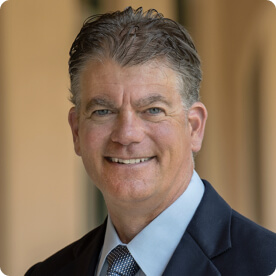As always, our team welcomes the opportunity to be your first call the minute you begin discussing philanthropy with a client. It is our honor – and our mission – to help you develop charitable giving plans to meet your clients’ philanthropic goals while also supporting the important tax and estate planning objectives you’re establishing for them.
Many of you are taking us up on this invitation. We’ve enjoyed the opportunity to talk with attorneys, accountants and financial advisors to help set philanthropy in motion for your clients. Recent conversations are very much reflected in the three articles we’re sharing in this issue.
- As clients’ retirement accounts continue to grow, so does the opportunity for clients (and San Diego) to benefit from careful and intentional charitable planning. San Diego Foundation (SDF) can help you serve clients who may be among the newly-minted “401(k) millionaires” as well as clients who crossed that threshold years ago.
- Clients wear many hats. They are children, parents, siblings and volunteers for charities. Many of your clients are also corporate executives or small business owners. Addressing your clients’ corporate giving needs alongside their individual and family philanthropy priorities is sometimes an overlooked component of estate and financial planning. SDF can help.
- A common theme during conversations with advisors is the importance of San Diego Foundation’s ability to help clients take a holistic approach to charitable giving. This is especially relevant in light of the steady drumbeat of news about the IRS’ focus areas. Our team is always on top of the issues and happy to share insights.
We look forward to continuing the conversation with you all.
Advising the Charitable Millionaire Next Door
At the end of 2024’s first quarter, an estimated 485,000 Americans could count themselves among the so-called “401(k) millionaires,” meaning the balance in their employer-sponsored retirement plans has reached the $1 million level. Thanks in part to stock market rallies during the first part of the year, that’s a larger number than ever before. Many of these 401(k) accounts will be rolled over into IRAs after retirement and the assets will continue to grow.
With so many of your charitably inclined clients holding large sums of money in 401(k)s and IRAs, now is an important time for a brief refresher course on the benefits of deploying these accounts to achieve clients’ philanthropic goals.
Indeed, although a charitable bequest of any type of property can help achieve a client’s estate planning and legacy goals, retirement accounts are especially powerful. When your client names a public charity, such as a donor-advised fund (DAF) or other fund at SDF, as the beneficiary of a traditional IRA or qualified employer retirement plan, your client achieves extremely tax-efficient results. Here’s why:
- First, the client achieved tax benefits over time as the client contributed money to a traditional IRA or to an employer-sponsored plan. That’s because contributions to certain retirement plans are what the IRS considers “pre-tax”; your client does not pay income tax on the money used to make those contributions (subject to annual limits).
- Second, assets in IRAs and qualified retirement plans grow tax-free inside the plan. In other words, the client does not pay taxes on the income generated by those assets before distributions start in retirement years, allowing these accounts to grow rapidly.
- Third, when a client leaves a traditional IRA or qualified plan to a fund at SDF or another charity upon death, the charity does not pay income taxes (or estate taxes) on those assets. By contrast, if the client were to name children as beneficiaries of an IRA, for example, those IRA distributions to the children are subject to income tax (and potentially estate tax), and that tax can be hefty given the tax treatment of inherited IRAs.
So, if your client is deciding how to dispose of stock and an IRA in an estate plan and intends to leave one to children and the other to charity, leaving the IRA to charity and the stock to children is a no-brainer. Remember, the client’s stock owned outside of an IRA gets the “step-up in basis” when the client dies, which means that the children won’t pay capital gains taxes on the pre-death appreciation of that asset when they sell it.
Speaking of savvy giving techniques using IRAs, a client who is 70 ½ or older can make tax-efficient gifts directly from an IRA to a qualified charity (including certain types of funds at SDF), up to $105,000 per year. This is known as a Qualified Charitable Distribution (QCD).
Our team is always happy to work with you to ensure that your clients are maximizing their assets to fulfill their charitable giving goals, both during their lives and through legacy gifts.
Companies Need Philanthropy Advice, Too
It’s relatively straightforward to see how philanthropy figures into the financial and estate plans you build for individuals and families. After all, many of these clients are already supporting their favorite causes in San Diego, and it’s your job to make sure they know about all the options for structuring both their near-term and long-term plans to give to charity using techniques that achieve both philanthropic goals and tax goals.
What you might not always consider, though, is that many of your clients are executives in companies whose leaders want the company itself to lean into charitable giving. That’s why it’s wise to be aware of best practices in corporate philanthropy and know the ways SDF can help.
For example, establishing a corporate donor-advised fund – essentially functioning and named as a corporate foundation – helps corporate executives organize the company’s giving in a convenient, 501(c)(3)-qualified structure, avoiding the time and expense that would be required for the company to establish and maintain a separate foundation entity.
The company can fund the corporate donor-advised fund each year (especially in really good years!), thereby organizing charitable donations to a wide range of nonprofits through a single source of funds. This structure can help maintain historical corporate giving levels even when the company experiences a down year.
At SDF, we partner with some of San Diego’s largest companies, including Cox Communications, the WD-40 Company, SDG&Em Qualcomm and Hologic, on their custom corporate giving strategies.
What’s more, many companies coordinate with us to offer DAFs to employees, especially to take advantage of company stock gifts. A program like this is a perk for employees who enjoy organizing their giving and using SDF’s many tools and services. The program also helps inspire employees to get more involved in the community, which benefits everyone.
Often, San Diego Foundation takes on a back-office role for a company’s matching gifts program, grant administration and giving strategy. For example, we can help guide corporate leadership in creating and administering a program that matches employees’ volunteer time with dollars. In addition, SDF can help a company create and implement a strategy for responding to and evaluating funding requests to align with the company’s goals for supporting and prioritizing causes.
Finally, SDF can help establish and administer employee giving and disaster relief campaigns. The foundation’s tools for receiving and processing donations can help a company and its employees respond quickly and meaningfully to disasters and other urgent community needs.
Many corporate partners appreciate our infrastructure, reporting practices and compliance protocols to ensure that all tax laws and other IRS requirements are met. Instead of the company bearing these responsibilities, we take it on. Corporate executives regularly view the relationship with SDF as a very wise outsourcing move.
We look forward to working with you and your clients who are corporate executives or even local small business owners who are excited to give back to the region where they’ve built businesses and developed lasting relationships with employees and customers.
Download our Custom Corporate Giving Guide
IRS Updates
As your go-to resource for charitable giving techniques, our team pays close attention to best practices in addressing the broad range of your clients’ charitable intentions to support both near-term and long-term community needs. This includes tracking legal developments that may impact philanthropy broadly, impact specific giving vehicles, and everything in between.
For example, we pay attention to the IRS’s plan to increase audits of wealthy taxpayers so that our team is better positioned to help you and your clients understand the requirements of valuing gifts to charity. And we’re gearing up to help you and your clients incorporate charitable giving vehicles as a way to blunt the potential impact of the anticipated estate tax exemption sunset. And we’re watching the IRS scrutinize aggressive techniques using annuities inside charitable lead trusts. And so much more.
Another issue we’re watching closely is the latest news on the IRS’s proposed regulations of DAFs. In February, SDF submitted testimony to the Treasury and IRS on the proposed regulations. You can read the letter here.
We’ve studied the transcript from the public hearings in early May, and it was inspiring to see so many community foundation leaders share their recommendations urging that any new regulations not disrupt the positive and productive working relationships between community foundations and advisors who are helping their clients achieve philanthropic goals.
At this point, no one can predict what will happen with the proposed regulations – whether and how they will be revised or when they might become effective, if ever. As always, our team is staying on top of the issues. We’ll keep you informed.
Of course, a DAF is just one of many types of funds your clients can establish at SDF. We offer donor-advised funds, endowment funds, field-of-interest funds, scholarship funds, designated funds, and a wide range of planned giving and legacy options for clients who want to invest in San Diego’s long-term needs.
The donor-advised fund is popular because it allows your client to make a tax-deductible transfer of cash or marketable securities that is immediately eligible for a charitable deduction. Then, your client can recommend gifts to favorite charities from the fund to meet community needs as they emerge.
Our team finds it especially rewarding to work with you and your clients to explore a diversified portfolio of giving vehicles. A client’s portfolio might include a donor-advised fund and perhaps also one or more of a variety of other tools, such as a bequest, unrestricted gift, charitable trust, or endowment gift.
Above all, we are confident in our ability to continue to work collaboratively with you and other advisors for years to come to help fulfill your clients’ philanthropic wishes.
Learn More
For nearly 50 years, we have partnered with an extensive network of wealth advisors, estate planning attorneys, tax planners and other financial advisors to help high-net-worth clients and families achieve financial planning objectives and charitable giving goals while maximizing tax deductions.
If you want to learn how we can help meet your clients’ financial planning and charitable giving goals in 2024, contact me at (858) 245-1508 or jrogers@sdfoundation.org.


















